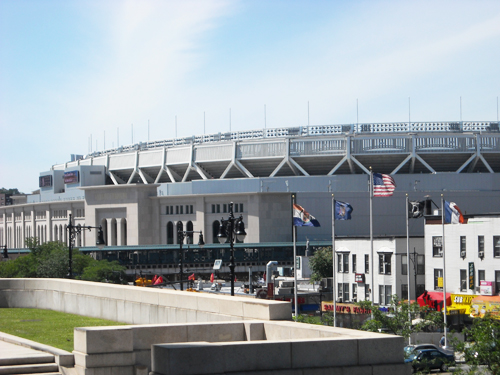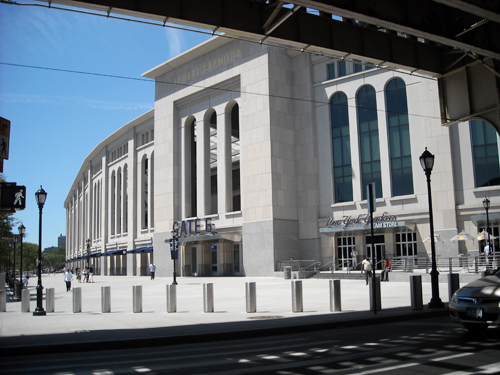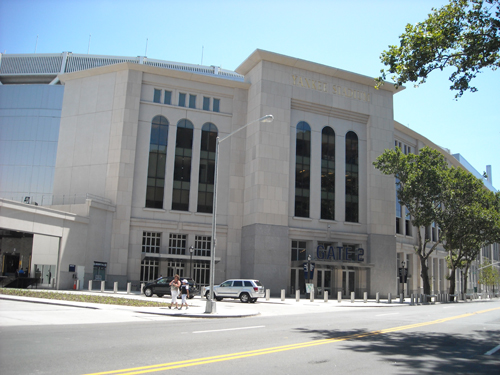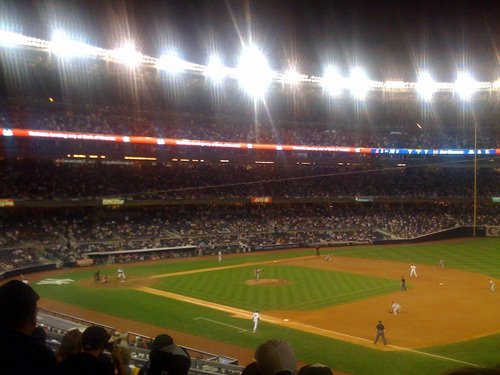Yankee Stadium
161st Street (southwest corner) and River Avenue
Osborne Engineering Company, 1923; redesigned, Praeger-Kavanagh-Waterbury, 1976; rebuilt, 161st Street (northwest corner) and River Avenue, Populous (formerly HOK Sport), 2009
When, in 1915, Colonels Ruppert and Huston were scouting-out a home for their new American League ball club, they briefly considered the Bronx. The flats alongside the Harlem River near Macombs Dam Bridge were occupied by nothing more significant than a sawmill. And a spasm of reform had weakened the grip of Tammany bureaucrats, who had persistently favored the National League by mapping streets through every plot of land selected by the upstart American League. But one insurmountable problem remained: there was no way to bring the crowds to 161st Street.
By 1921, matters had become more urgent. The Yankees had been turned out of their temporary shared tenancy of the Polo Grounds because the amazing success of their recently-acquired heavy hitter, Babe Ruth, was embarrassing their landlord, John McGraw, and his National League Giants. Unlike the intricate tactics of the traditional “inside game,” titanic home runs that cleared the bases were attracting a huge new audience. Over a million fans had come to see Ruth hit fifty-four runs in his first New York season.
And now there was a way to transport these masses to the west Bronx, where they would be transported by Ruth. The Woodlawn line of the Interborough Rapid Transit, completed in 1917, rose from a tunnel at 156th Street onto an elevated structure, stopping right next to the River Avenue wall of a projected ballpark so large it was to be dignified as a “stadium.” True, there was still a hitch in the street plan. The politicians agreed to close off 158th Street and Cromwell Avenue, but the architects were left with an irregular five-sided plot in which to set their diamond. The result was a park with an outfield long and tricky on the left, shorter and inviting on the right. That such a configuration favored left-handed hitters was surely accidental, although other franchises muttered that the “house that Ruth built” was also a house custom-built for the lefty slugger. (The right-field bleachers quickly became known as “Ruthville.”)
Otherwise, the design by the Osborne Engineering Company was mainly notable for being the first to have three decks, although when built the grandstand, originally meant to circle the field, stopped short at the foul lines. Sight-obstructing steel columns rose to a shed roof fringed with an Art Deco copper frieze (fans liked to call it “the façade”), on which flagpoles were fixed between bridge-like vaults punctured with round-headed arches. The arched motif, vaguely reminiscent of nearby Highbridge, was taken up again in the tall windows on the concrete exterior of the Stadium. Spread-eagle roundels flanking the main gates completed the sparse decoration.
The Stadium opened in April, 1923, with a parade led by Sousa and a three-run homer by Ruth. Alterations began not long thereafter, extensions of the stands and re-balancing of the awkward playing field which continued into the ‘seventies, when New York City undertook to buy and modernize the building. To the consternation of many, a municipality on the brink of financial disaster spent about 75 million dollars (and perhaps another million in debt service) to satisfy team owners who felt that the field and the Bronx had become inhospitable settings for baseball.
The physical changes, completed in 1976, were not remarkable. Traditionalists lamented the careless treatment of revered details like the “facade” (reduced to a fringe over the bleachers) and the memorials in center field. Mainly there was a great deal more parking, while the subway which had made Yankee Stadium possible suffered from a decay of services, along with the whole borough. It was from the press box of the rebuilt Stadium that Howard Cosell made his grim 1977 announcement, “Ladies and gentlemen, the Bronx is burning.”
Thirty-three years later, in the midst of another financial crisis, a brand new stadium opened across 161st Street from the deserted original, soon to be demolished. 2009’s Yankee Stadium has been built on public parkland in adjoining Macombs Dam Park, and again supported by the City, at an estimated cost of 450 million dollars. (With a total price of 1.3 billion dollars, the new stadium is the second most expensive in the world.)
Indicating the direction being taken by baseball in the twenty-first century, new Yankee Stadium, more than half again as large as its predecessor, has fewer seats, but 56 private “luxury suites,” 13 restaurants/lounges, and 11,560 square feet of souvenir stores. Grandstand loyalists, meanwhile, have been placated with an earnest simulation of details from the original building. The exterior is once again wrapped in a tall stone arcade, buckled by a Gate Four equipped with eagle-roundels and gilt-lettering. The “facade,” cast in concrete this time, once again hangs above the upper deck. The field retains the shape of the old stadium’s final version (with a short right outfield). There are still three decks, although they don’t overhang one another like eager fans craning for a better look, as in Stadium I. Instead, the stands recede in a bowl shape that leaves more spectators at lower levels, but remote from the action.
While the manually-operated scoreboard installed in left field is unpardonable “old ball game” nostalgia, Bronxites will admire the reappearance of a gap in the fence over the right field bleachers, exactly as in the old stadium, which invites the crowd to watch the passing #4 subway trains and remember how this all began.
David Bady
Photographs:
Lehman College Art Gallery and Joshua Hoeltzel



